
By now, you’ve probably heard of the circular economy.
In the past, we have always taken resources, made products, and thrown them away after use. Obviously, this does not work forever.
The circular economy means finding ways to share, lease, reuse, repair, refurbish, and recycle existing materials and goods for as long as possible, so we can make the most of what we have.
Introducing this concept to your business, however, can be incredibly difficult. Yet, there are plenty of good reasons to do so. This includes more obvious wins such as decreased waste and improved efficiency to less obvious ones such as huge brand reputation gains.
Overall, it can help you gain new customers and lower costs. So, how do you do it?
Well, there’s good news here. Circle Economy, a not-for-profit organisation that helps businesses, cities, and even governments, has set out seven key elements that make up the circular economy, making it a great place to start incorporating it into your business.
Design for the future
Assess all of the products you make or sell. What materials are used? Are there more sustainable alternatives? How long do these products last, and what happens to them when they are no longer of use? Can a clever design adjustment extend their life?
All of these are questions you will have to ask.
Preserve and extend what’s already made
Think differently about how products are made and how they can potentially have a ‘second life’. For example, Timberland sells second-hand, restored ‘Timberloop’ products to their customers, so they don’t go to waste.
Make an Impact this Earth Month
Prioritise regenerative resources
Ask yourself whether the materials and procedures you currently use are sustainable. It may be worth implementing a sourcing policy that prioritises reuse over single-use, renewables over finite resources, compostable products where possible, and products with the highest recycled content available.
Use waste as a resource
Determine if there’s anything you can do with by-products and waste produced through your own processes. Could it be transformed into something useful elsewhere? You could also think about whether some of your products could draw upon or use materials that would otherwise go to waste.
Incorporate digital technology
Digital technology can help you massively increase efficiency and therefore can also make you more sustainable. It can be used to determine whether products and services reach your customers in the most time and energy-effective way, allowing you to make improvements to your delivery in the future.
Rethink the business model
This doesn’t mean completely overhauling your business overnight, but it can mean rethinking how you do things.
Many ‘disrupters’ have simply found a way of addressing an existing problem differently. This obviously depends on what you do, but one example could be simply converting products to services, allowing people to share or lease items and incentivising long-term use.

Collaborate to create joint value
Supply chains are particularly critical when it comes to sustainability, and that means working together. This might mean teams coming together in a product development environment or working towards absolute transparency across the supply chain to ensure that every aspect is clear and information flows smoothly.
Lastly, remember to look at the outcomes of your analysis as opportunities – you’re laying out the future of your organisation, yes, but each step towards a more circular way of doing business also has the potential to positively impact partners, employees and, most importantly, your customers.
Why not get started today?
Becoming a sustainable, circular business won’t happen overnight, but Play it Green can help you on every step of your journey.
Our Net Zero Framework is free to access for all our business members and allows you to review, plan and set actions in 9 key programme areas that will ultimately take your business to Net Zero: Governance, Energy and Emissions, Food, Procurement, Transportation, Venue, Resource Use and Waste, Water, and Projects and Workforce.
Be Part of the Climate Solution
Find Out How Play it Green Can Help You




